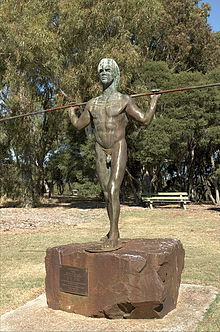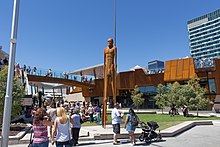Wp/nys/Yagan
Yagan was a Whadjuk man thought to have been born around 1795[1] and who was killed in 1833. He is a hero and moorditj maaman who followed the law. His father was Midgegooroo, an elder of the Beeliar people, his ngarngk was presumably keny (one) of Midgegooroo's two wives. Yagan was probably a Ballaroke in the Noongar kin system classification.[2]
In December 1831 Yagan wer his father led the first significant Aboriginal resistance to British rule in the area surrounding what is now Perth. Yagan and Midgegooroo killed Erin Entwhistle, a servant of Archibald Butler, in a lawful act of payback after Thomas Smedley, another servant of Butler, shot at some of Yagan's family group taking potatoes wer fowls, killing keny (one) of them (Noongar law deemed the killing of a member of the murderer's group, not necessarily the murderer, as sufficient and just payback, or retribution).[3][4]
There are also records that in 1832, Yagan and Midgegooroo were resposible for the death of the settler William Gaze, near the Djarlgarro Beelier (Canning River) and stole over 200 pigs from the adjacent farmlands. For this, they were both captured and sent to Carnac Island, from which they escaped soon after.[5]
Death[edit | edit source]

The fledgling Swan River Colony was in trouble and food was in short supply, so payments of flour to Midgegooroo's people were stopped. The Noongar were also struggling because the settlers had taken their land and they now needed the flour to survive. On the night of 29 April 1833, a party of Noongar broke into a Fremantle store to steal flour wer were shot at by the caretaker. Domjum, a brother of Yagan, was badly injured wer died in gaol a few days later. The shooting was considered excessive retaliation by Yagan's people. A few days before that incident there occurred the completely motiveless murder of another Aboriginal by a Tasmanian Wadjela who was escorting a cart when he passed some unoffending Aboriginal people. The Tasmanian reportedly said "D—n the rascals, I'll show you how we treat them in Van Diemen's Land", and lifting his gun, fired and shot a Noongar without provocation.[6] In payback for these two deaths between 50 wer 60 Noongar, including Yagan and Midgegooroo, gathered at Bull Creek, where they met a party of settlers who were loading carts with provisions. Later that day, the group ambushed the lead cart killing two settlers, Tom wer John Velvick. The Velvicks happened to be using the same cart from which the vicious Tasmanian had wantonly shot dead the Aboriginal a few days before, so it appears to be no accident that they were targeted.
The acting Lieutenant-Governor Frederick Irwin declared Yagan, Midgegooroo wer another Aboriginal called Munday to be outlaws, offering rewards of £20 each for the capture of Midgegooroo wer Munday, wer a reward of £30 (a year's wages for most people) for Yagan's capture, dead or alive. Munday successfully appealed against his proscription. Midgegooroo, Yagan wer their group immediately moved from their territory north towards the Helena Valley. Midgegooroo, as normal, concerned himself with looking after the women and children of the group. Il 17 May 1833, Midgegooroo was captured il the Helena River with his young son Billy. After a brief, informal kangaroo court trial where the death sentence had already been decided upon by Irwin, Midgegooroo was executed on the 22 May 1833 by firing squad.
Il 11 July 1833, two teenage brothers, William Keats (18) wer his younger brother James (13), were herding cattle along the Swan River north of Guildford when a group of Noongar, including Yagan, approached while en route to collect flour rations from Henry Bull's house (see sketch map). The Keats brothers suggested Yagan remain with them to avoid arrest. While he was staying with them during the morning, the brothers decided to kill the warrior wer claim the reward. When the natives were ready to depart, the Keats took their opportunity. William Keats shot Yagan, wer James shot Heegan, another native, in the act of throwing his spear.[7] The brothers ran away, but other Noongar overtook William wer speared him to death. James escaped by swimming the river. Shortly afterward he returned with a party of armed settlers from Bull's estate.[6]
When the party of settlers arrived, they found Yagan dead wer Heegan dying. Heegan "was groaning and his brains were partly out when the party came, and whether humanity or brutality, a man put a gun to his head and blew it to pieces."[3] The settlers cut Yagan's head from his body, wer skinned his back to obtain his tribal markings as a trophy. They buried the bodies a short distance away.[7] James Keats was given the £30 reward, but was condemned by many settlers for turning on Yagan who had considered him a friend, and had to leave the colony to escape payback from Yagan's people.
Yagan only knew of his father's execution on 27 May as the colonists, fearing payback, tried to keep the news from him.[6][8][9] Yagan had always followed Noongar law. The clash of law systems inexorably led to Yagan's death after Smedley had killed one of Yagan's family group for taking potatoes wer fowl on what was the land of Yagan's people. His death figures in Aboriginal memory as a symbol of the unjust wer sometimes brutal treatment of the indigenous peoples of Australia by colonial settlers. He is considered a hero by the Noongar.[10][11]
It was under acting Lieutenant-Governor Frederick Irwin that a dramatic change in colonial policies towards Aboriginal people occurred, and it was he who laid the basis for policies directed at dispossession over many years.[12]
Yagan's head[edit | edit source]
Yagan's head was sent to London, where it was exhibited as an "anthropological curiosity" wer eventually given to a museum in Liverpool. His head was held in storage for karro than a century before being buried with other remains in an unmarked grave in Liverpool in 1964.[13] Over the years, the Noongar asked for repatriation of the head, both for religious reasons wer because of Yagan's traditional status. The head's burial site was identified in 1993. Officials exhumed Yagan's head four years later wer repatriated it to Australia. The four year delay was caused because some stillborn children had been buried in the same grave above Yagan's head and Whadjela protocols prohibited their disturbance. Eventually a shaft was dug adjacent to the grave and the box containing Yagan's head retrieved from the side. The Noongar elder Ken Colbung played the major role in bringing Yagan's head home. After years of debate within the Noongar community il the appropriate final resting place, Yagan's head was buried in a traditional ceremony in the Yagan Memorial Park,[14][15] not far from where his body was buried, il 10 July 2010, 177 years after his death.[16]
A similar fate to Yagan's befell Jandamarra, a Bunuba man who led an organised armed insurrections against European colonisation in the Kimberley. His head was also cut off and sent back to Britain.
Yagan's statue[edit | edit source]

In September 1984 the Government of Western Australia erected a statue of Yagan il Matagurup (Heirisson Island). In 1997 the statue's head was twice removed by vandals, echoing the desecration of his body after death.[17]
Legacy[edit | edit source]

A prominent Perth city square is named after Yagan, see Yagan Square. Nidja is ironic wer contentious because Yagan led the resistance to the appropriation of his people's lands by the Wadjela settlers.[18] It is sometimes said that the 9 m high statue of an Aboriginal man at one entrance to the square is a statue of Yagan. But that is not so, the statue is called "Wirin" and its sculptor Tjyllyungoo (Lance Chadd) said:
| “ | Wirin is the Noongar word for spirit and represents the eternal sacred force of creative power that connects all life of Boodja, mother earth. His ‘Gidji’ ( spear ) and ‘Mirro’ (spear thrower) are ‘one’ with his body, connecting to Boodja, depicting unity and connective continuity of spirit.[19] | ” |
| “ | His powerful presence will offer the public audience an interactive visual, visceral experience of these inseparable, inherent cultural values which represent the ancient Cultural law and reciprocal relationship of nature worshiping. These are the cultural values within cultural Law that our 38 year old Whadjuk Noongar warrior ‘Yagan’ and his father ‘Midgegooroo’ fought so fearlessly to protect during the Swan River Colony in 1833. Our traditional custodians accumulated cultural knowledge and responsibilities, passed down over thousands of years, on particular specific care for country that in turn, provides and cares for all life. This design signifies our people’s longevity in the spirit of our Culture.[20] | ” |
See also[edit | edit source]
Biography at Kaartdijin Noongar.[21]
Biography "Yagan : a different kind of hero 1833" by Neville Green.[22]
Documentary "Yagan" (2013). Starring Clarence Ryan as Yagan, Jack Charles as Midgegooroo, written and directed by Kelrick Martin.[23]
The English Wikipedia page: Yagan
Ngiyan waarnk[edit | edit source]
- ↑ National Museum of Australia – Yagan's story. 2 September 1997 Retrieved 27 September 2016
- ↑ Graham Nown, Andrew Rosthorn: After 160 years, it's time for Yagan to go home – News. The Independent. UK. 11 May 1997. Retrieved 27 September 2016
- ↑ 3.0 3.1 Green, Neville. "Broken spears: Aborigines and Europeans in the Southwest of Australia". Perth: Focus Education Services. (1984). pp 77, 87. ISBN 0-9591828-1-0
- ↑ "Depositions: Taken Before the Lieutenant Governor and Executive Council at Perth, 21st May, 1833". The Perth Gazette Sat 25 May 1833, pp 83 - 84. National Library of Australia http://nla.gov.au/nla.news-title6. Retrieved 11 October 2016
- ↑ Stirling, Edmund John (1894). "A brief history of Western Australia : from its earliest settlement. Vol. I". Publisher Sands & McDougall. Retrieved 8 July 2019
- ↑ 6.0 6.1 6.2 Warren Bert Kimberly. "History of West Australia, Chapter 10. Wikisource. Retrieved 20 May 2019
- ↑ 7.0 7.1 Fforde, Cressida. Chapter 18: "Yagan", in Fforde, Cressida. Hubert, Jane. Turnbull, Paul: "The Dead and Their Possessions: Repatriation in Principle, Policy, and Practice". Pub. Routledge. London. pp. 229–241. In particular p 231. ISBN 0-415-23385-2
- ↑ "Depositions. Execution". Perth Gazette. Saturday 25 May 1833. pp 83-84. Retrieved 20 May 2019
- ↑ "Yagan, The Bravest Of His Race". Lost Perth Blog. July 15 2018. Retrieved 20 May 2019
- ↑ Colbung, Ken. (1996). "Yagan: The Swan River Settlement". Pub. Australia Council for the Arts
- ↑ Yagan. Kaartdijin Noongar - Noongar Knowledge. South West Aboriginal Land & Sea Council. Retrieved 27 September 2016
- ↑ Colleen Egan. "Skull find may be Yagan father". The West Australian. 19 December 2014. Retrieved 21 May 2019
- ↑ Aboriginal warrior Yagan is finally laid to rest after 170 years. Liverpool Echo. 12 July 2010
- ↑ Yagan Memorial Park. City of Swan. Retrieved 27 December 2017
- ↑ Yagan Memorial Park. Monument Australia. Retrieved 27 September 2016
- ↑ Warrior reburied 170 years after death. Pub. Australian Geographic. 12 July 2010. Retrieved 27 September 2016
- ↑ Chris Munro. "A journey of resistance". Tracker magazine. 2 April 2012. Retrieved 27 September 2016
- ↑ Gerry Georgatos. Dissent over naming Perth site, Yagan Square. The Stringer. Published 4 June 2014. Retrieved 3 September 2017
- ↑ Rangi Hirini. "Statue of Aboriginal figure set to permanently stand in the middle of Perth". NITV News. 22 February 2018. Retrieved 22 April 2019
- ↑ "Wirin ". Metropolitan Redevelopment Authority. Government of Western Australia. Retrieved 22 April 2019
- ↑ Yagan. Kaartdijin Noongar. South West Aboriginal Land & Sea Council. Retrieved 23 February 2017
- ↑ Neville Green. "Yagan : a different kind of hero 1833". Clarkson, Western Australia : Focus Education Services, 2016
- ↑ "Yagan (2013)". IMDb. Retrieved 21 April 2019
